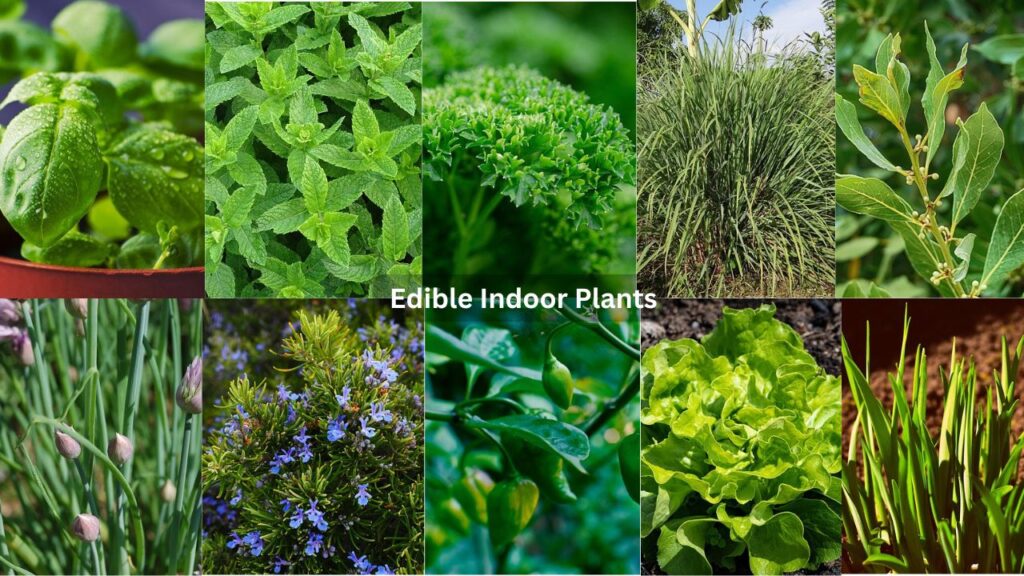Introduction
Growing plants indoors doesn’t just enhance the aesthetics of your living space — it can also bring fresh, edible delights right to your kitchen! Whether you live in a small apartment or a house with limited outdoor gardening space, you can still grow and enjoy a variety of edible indoor plants. These green companions not only offer fresh herbs, vegetables, and leaves but also infuse your meals with flavor, aroma, and nutrition.
Let’s dive into the 10 best edible indoor plants you can grow at home — plants that thrive indoors and add a farm-to-table touch to your meals.
1. Basil Plant
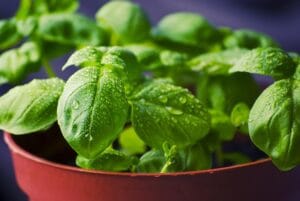
Growing basil indoors ensures a constant supply of fresh, aromatic leaves year-round. It thrives in sunny windows, adds flavor to countless dishes, and enhances indoor air quality. Plus, it’s easy to care for, making it perfect for beginner gardeners and home cooks who love cooking with fresh, organic ingredients.
Indoor Care Tips:
- Light: Place in a sunny south-facing window (at least 6 hours of light daily) or use a grow light.
- Watering: Keep the soil moist but not soggy. Avoid wetting the leaves.
- Temperature: Prefers 70–80°F (21–27°C).
Kitchen Uses:
- Pesto sauce
- Tomato-based dishes
- Fresh salad garnish
- Thai curries and stir-fries
Pro Tip: Pinch off flower buds to encourage leaf growth and extend its lifespan.
2. Mint plant
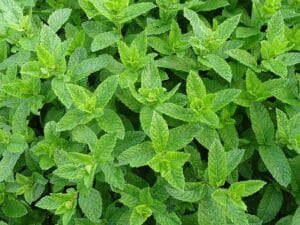
Growing mint indoors ensures a fresh, aromatic supply year-round right at your fingertips. It’s easy to maintain, repels pests naturally, and adds instant flavor to teas, salads, and desserts. Indoor mint also prevents its invasive spreading, making it a convenient, space-saving herb for any kitchen or apartment garden.
Indoor Care Tips:
- Light: Indirect light or 4–6 hours of direct sunlight.
- Watering: Regular watering. Mint likes moist soil.
- Container: Use a deep pot to prevent roots from spreading uncontrollably.
Kitchen Uses:
- Mojitos and herbal teas
- Salads and chutneys
- Yogurt dips and sauces
- Garnish for desserts
Pro Tip: Snip frequently to keep it bushy and productive.
3. Chives plant
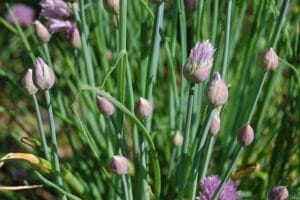
Growing chives indoors is easy and rewarding. They require minimal space, thrive on sunny windowsills, and provide a fresh, mild onion flavor year-round. Chives regrow quickly after harvesting, making them perfect for small kitchens. Plus, their vibrant green shoots add beauty and freshness to your indoor herb garden.
Indoor Care Tips:
- Light: Needs 6–8 hours of sunlight. Supplement with a grow light if needed.
- Watering: Water when the soil feels dry to the touch.
- Container: Well-draining pot is ideal.
Kitchen Uses:
- Garnish for soups and baked potatoes
- Egg and cheese dishes
- Compound butters
- Herb dips and spreads
Pro Tip: Trim down to 1–2 inches above the soil every few weeks to encourage regrowth.
4. Parsley plant
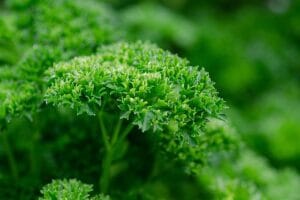
Growing parsley indoors ensures a constant supply of fresh, flavorful leaves right at your fingertips. It thrives in pots on sunny windowsills, adds vibrant greenery to your kitchen, and eliminates the need for store-bought herbs. Indoor parsley also avoids pests, making it a clean, convenient, and healthy choice for home cooks.
Indoor Care Tips:
- Light: Needs 5–6 hours of sunlight daily.
- Watering: Keep soil consistently moist.
- Fertilizing: Use organic liquid fertilizer every 4–6 weeks.
Kitchen Uses:
- Garnish for almost any dish
- Adds flavor to soups, stews, and tabbouleh
- Blends into green sauces like chimichurri
Pro Tip: Harvest outer leaves first to allow younger shoots to grow.
5. Rosemary plant
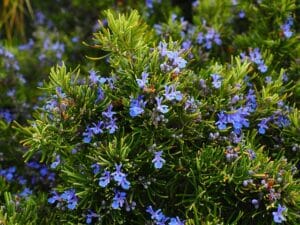
Growing rosemary indoors provides year-round access to fresh, aromatic herbs for cooking while enhancing your home’s air quality and ambiance. It’s a low-maintenance plant that thrives in pots, adds greenery to your kitchen, and fills the room with a delightful fragrance, making it both practical and decorative.
Indoor Care Tips:
- Light: Requires full sun (6–8 hours). Use a grow light in winter.
- Watering: Allow soil to dry out slightly between waterings.
- Container: Use a clay pot for better drainage.
Kitchen Uses:
- Roasted vegetables and meats
- Herb bread and focaccia
- Infused oils and vinegars
- Marinades and sauces
Pro Tip: Avoid overwatering. Rosemary hates wet feet.
6. Lemongrass plant
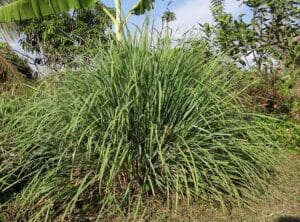
Growing lemongrass indoors provides a fresh, citrusy herb year-round, perfect for teas, soups, and stir-fries. It purifies the air, repels insects naturally, and adds a pleasant aroma to your home. Easy to grow in pots from store-bought stalks, lemongrass thrives on sunny windowsills with minimal care.
Indoor Care Tips:
- Light: At least 6 hours of bright light daily.
- Watering: Water regularly; loves humidity.
- Starting Tip: You can grow it from grocery store stalks by placing them in water until roots form.
Kitchen Uses:
- Thai and Vietnamese soups
- Herbal tea and infusions
- Curry pastes and stir-fries
- Flavoring for rice dishes
Pro Tip: Harvest stalks by cutting at the base when they reach about 12 inches tall.
7. Lettuce plant

Growing lettuce indoors ensures a year-round supply of fresh, chemical-free greens right at your fingertips. It’s easy to cultivate, requires minimal space, and grows quickly. Indoor lettuce avoids pests and weather issues, making it perfect for beginners and urban gardeners looking for a healthy addition to salads and meals.
Indoor Care Tips:
- Light: 10–14 hours of light required; use LED grow lights.
- Watering: Keep soil moist but avoid overwatering.
- Container: Use shallow but wide containers for multiple heads.
Kitchen Uses:
- Fresh salads
- Lettuce wraps
- Sandwiches and burgers
- Garnish for plates
Pro Tip: Try cut-and-come-again harvesting: trim outer leaves and let the plant keep growing.
8. Chili Peppers plant
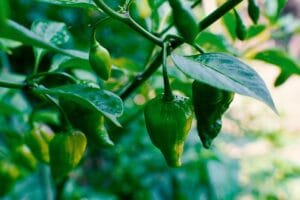
Growing chili peppers indoors allows you to enjoy a year-round supply of fresh, spicy peppers right from your kitchen. Indoor cultivation offers better control over temperature, light, and pests, ensuring healthy growth. Plus, their colorful fruits add beauty and flavor to your home and meals alike.
Indoor Care Tips:
- Light: Needs full sun (12+ hours); grow lights are a must in winter.
- Watering: Moderate watering; don’t let soil dry out completely.
- Pollination: Gently shake flowers or hand-pollinate using a cotton swab.
Kitchen Uses:
- Spice for curries and sauces
- Homemade chili oil
- Pickled peppers
- Stir-fry and salsas
Pro Tip: Choose dwarf or compact varieties like ‘Cayenne’ or ‘Jalapeño’ for indoor success.
9. Garlic Greens plant
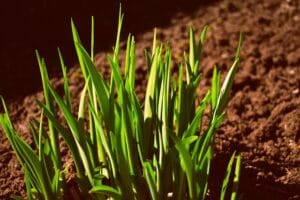
Growing garlic greens indoors is easy, fast, and rewarding. They require minimal space, thrive on windowsills, and provide a fresh, mild garlic flavor perfect for cooking. Unlike garlic bulbs, greens grow quickly from cloves and can be harvested multiple times, making them a sustainable, flavorful addition to your indoor garden.
Indoor Care Tips:
- Starting Tip: Plant a garlic clove (pointy end up) in soil or water.
- Light: Needs 6 hours of light daily.
- Watering: Keep soil moist but well-drained.
Kitchen Uses:
- Add to stir-fries, scrambled eggs
- Herb butters
- Salad toppings
- Pasta sauces
Pro Tip: Harvest the green shoots once they reach 8–10 inches. Keep replanting for continuous greens.
10. Bay Laurel plant

Growing Bay Laurel indoors provides a convenient, year-round source of aromatic bay leaves for cooking. It’s a hardy, low-maintenance plant that purifies the air and adds greenery to your home. Indoors, it’s protected from pests and harsh weather, making it easier to manage and harvest fresh, flavorful leaves anytime.
Indoor Care Tips:
- Light: Prefers bright, indirect sunlight.
- Watering: Allow the top inch of soil to dry before watering.
- Air Circulation: Needs good air flow to prevent fungal disease.
Kitchen Uses:
- Flavor soups, stews, and sauces
- Infused oils and broths
- Marinades and brines
Pro Tip: Always dry the leaves before using for better flavor and texture.
Indoor Gardening Tips for Success
- Use the Right Pots: Choose pots with drainage holes and trays to avoid waterlogging.
- Soil Quality Matters: Use well-draining potting mix, preferably organic.
- Rotate Your Plants: Rotate every few days to ensure even sunlight exposure.
- Prune Regularly: Trimming encourages new growth and prevents legginess.
- Keep Clean: Wipe leaves occasionally to remove dust and pests.
Why You Should Grow Edible Plants Indoors
- Saves Money: No need to run to the store for herbs and greens.
- Freshness at Your Fingertips: Harvest just before cooking.
- No Pesticides: You’re in control of what goes on your plants.
- Therapeutic Hobby: Gardening improves mental well-being.
- Sustainable Living: Reduces packaging waste and carbon footprint.
FAQ
- Can you grow edible plants indoors year-round?
Yes, most edible plants can grow indoors year-round with the right light, temperature, and care. - Do indoor edible plants need grow lights?
If your home lacks natural sunlight, especially in winter, grow lights can help your plants thrive. - What’s the easiest edible plant to grow indoors?
Mint and basil are among the easiest and fastest-growing edible indoor plants. - Can you grow vegetables like tomatoes indoors?
Yes, but they require large containers, strong light, and hand pollination. - How do I keep indoor herbs from dying?
Ensure proper light, avoid overwatering, and harvest regularly to promote new growth. - How long do edible herbs last indoors?
With proper care, herbs like rosemary and bay laurel can live for years. - What kind of soil is best for indoor herbs?
A well-draining potting mix, ideally organic, is best for most herbs and vegetables. - Do indoor plants attract pests?
Occasionally. Keep leaves clean and watch for pests like aphids or spider mites. - How often should I water edible indoor plants?
Water needs vary, but most herbs prefer moist (not soggy) soil. Always check with your finger first. - Can I use kitchen scraps to grow indoor plants?
Yes! Scallions, garlic, lemongrass, and even lettuce can regrow from kitchen scraps.
Conclusion
Creating an edible indoor garden is not just about growing plants — it’s about cultivating a lifestyle rooted in freshness, wellness, and sustainability. With a sunny windowsill, some patience, and a bit of care, you can enjoy fresh herbs, vegetables, and greens right from your kitchen.
Whether it’s snipping basil for pasta or harvesting garlic greens for a stir-fry, these 10 edible indoor plants are more than just houseplants — they’re culinary companions that bring the garden to your plate.

